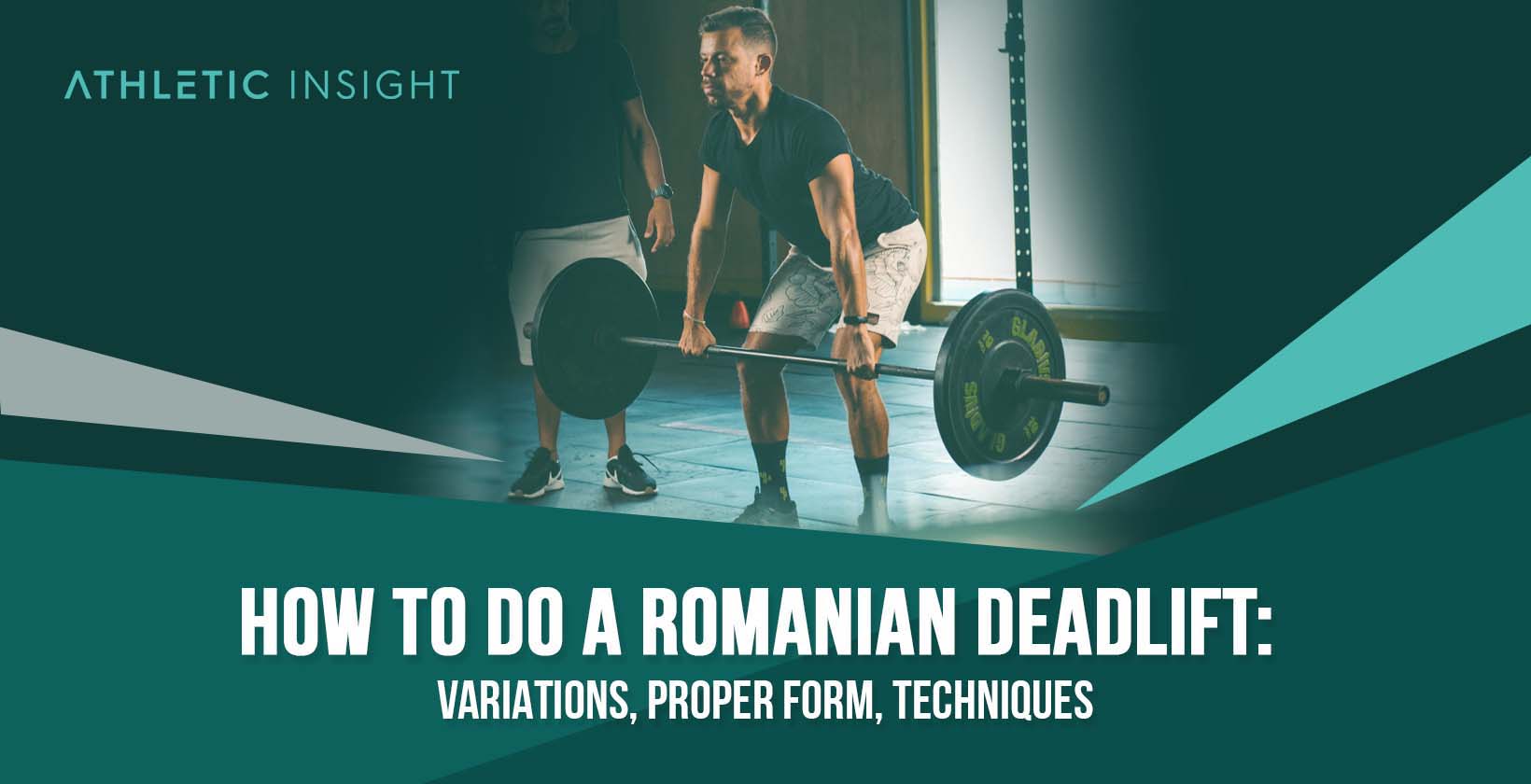The Romanian Deadlift, or RDL, is a compound lift variation of the traditional deadlift. The most significant benefit of this variation is the added focus on the hamstrings. In addition to developing the hamstrings, the glutes, erectors, traps, lats, rhomboid, lower back, and grip strength benefit from this beginner-friendly exercise.
Proper Romanian Deadlift form starts with the setup. First, stand with feet in line with the shoulders, toes forward, and barbell over the shoelaces. Next, hinge at the waist and bend the knees slightly. Then, grab the bar with an overhand grip while keeping the back flat.
Finally, use the hamstrings and hips to lift the bar with slow, controlled movements. Once the athlete reaches a standing position, with arms straight down, contract the core, glutes, and upper back during a pause before returning to the starting position.
Aside from the traditional Romanian Deadlift, there are four other types. The Romanian Deadlift variations include the single-leg Romanian deadlift, dumbbell split-leg Romanian deadlift, trap-bar Romanian deadlift, and dumbbell Romanian deadlift.
The leading Romanian Deadlift mistakes involve athletes using improper form or attempting to lift more weight than they can manage. Common mistakes with the Romanian Deadlift form include letting the bar move too far from the body, rounding the lower back, and bending the knees too much.
Common injuries with this exercise include muscle strains, usually the hamstrings or back, meniscus tears in one or both knees, and ruptured muscles. The importance of developing good Romanian Deadlift techniques cannot be understated. Learning proper form isn’t just the best way to master Romanian Deadlift. It’s also critical to preventing injury.
How to Perform Romanian Deadlift With Proper Form
Proper Romanian Deadlift form includes keeping the back straight, holding the bar close to the body throughout the exercise, and isolating the correct muscles at each point.
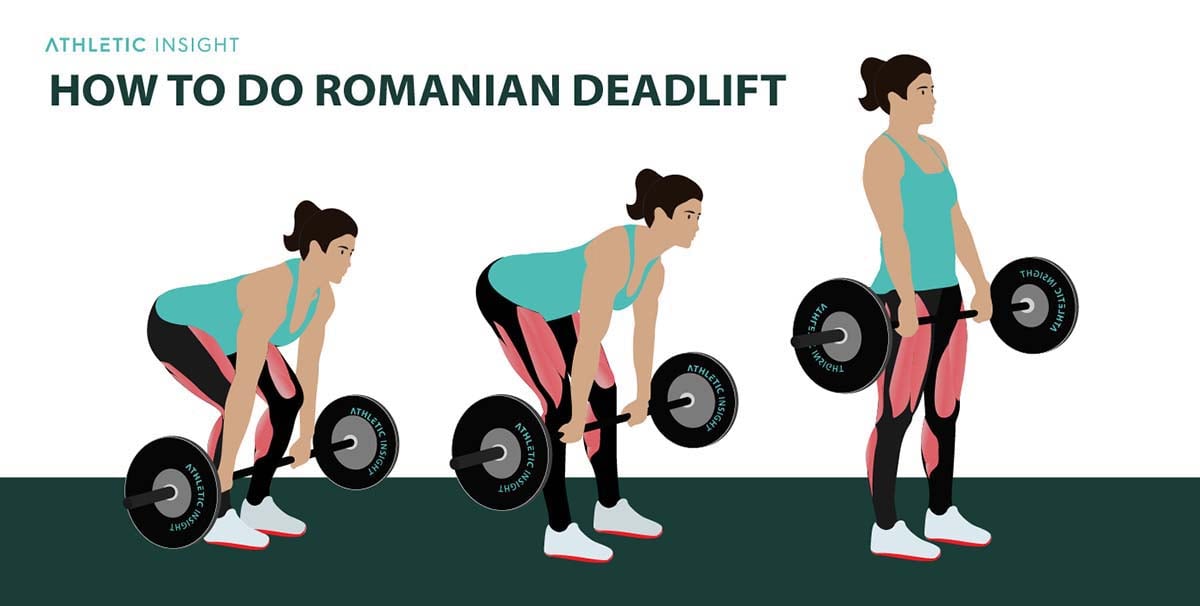
- Start with a proper setup
- Hinge at the hips
- Use an overhand grip, keep the bar close and lift
- Pause at the top
Embracing proper form is crucial to making gains in strength and power without sustaining an injury. Moving slowly through the entire exercise allows athletes to isolate the target muscle groups and gives them time to stop if anything feels wrong.
1. Start With a Proper Setup
Proper setup is crucial because it sets the tone for the entire exercise. From the moment an athlete approaches the bar, they should take care to line up correctly. Stand straight with feet shoulder-width apart and toes pointing forward. The bar should be just above the shoelaces.
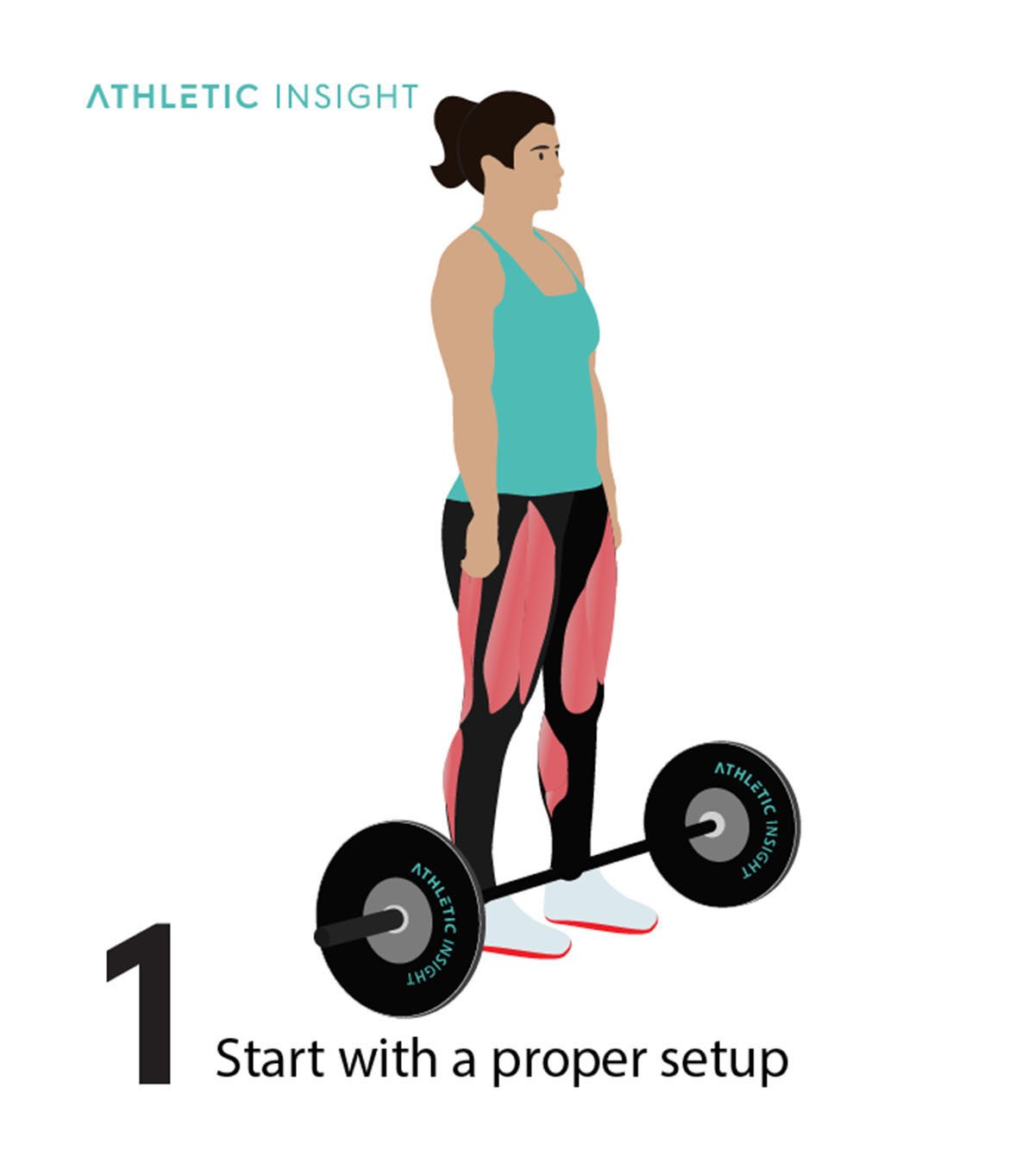
2. Hinge at the Hips
Without arching the back, hinge forward at the hips so that the shoulders are over the bar. Bend the knees slightly so that it’s comfortable to grab the bar with arms fully extended. Make sure weight is balanced between the feet.
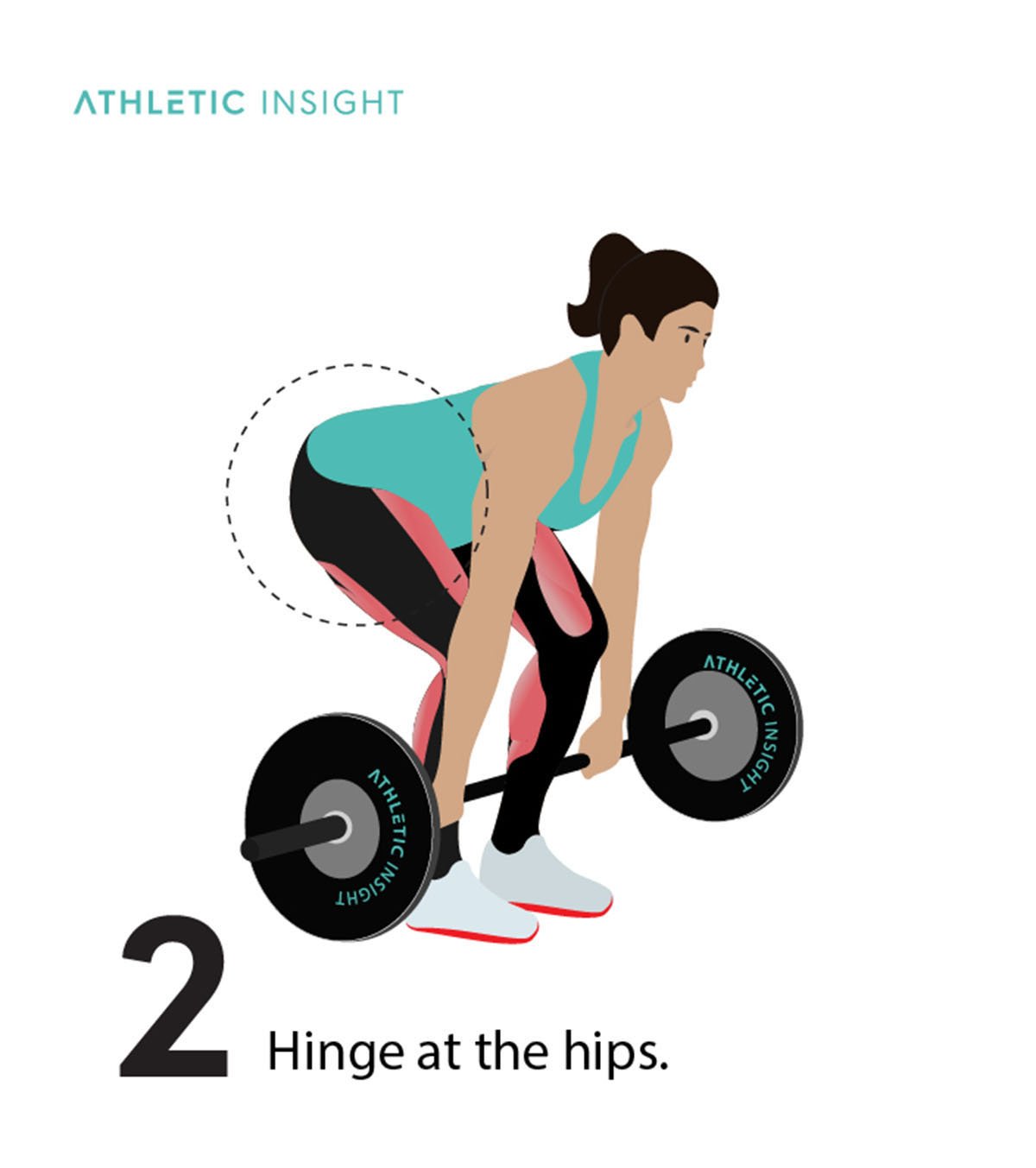
3. Use an Overhand Grip, Keep the Bar Close and Lift
Grab the bar with hands slightly outside the shoulders and use an overhand grip. Engage the core and keep the back flat. Keeping the bar close to the body, lift it in a smooth, controlled motion until it’s just a few inches above the knee, then stand up.
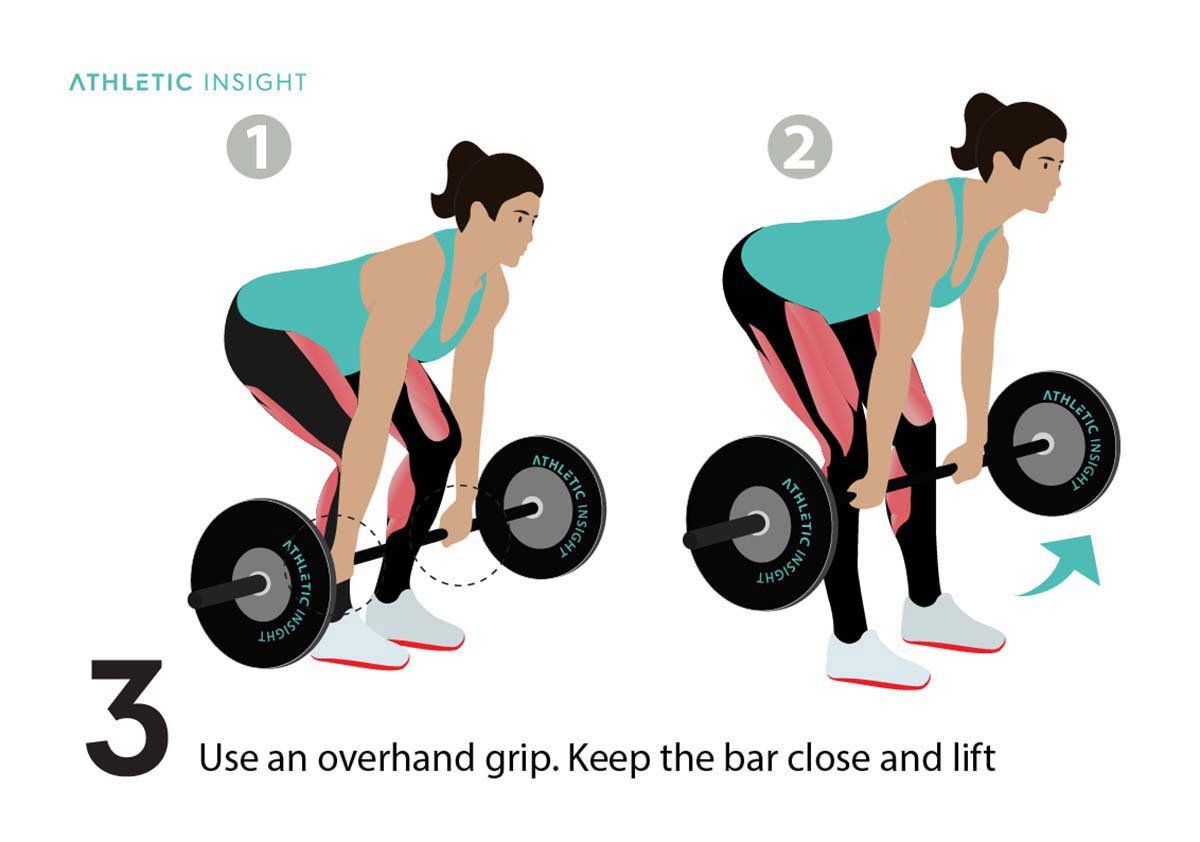
4. Pause at the Top
Pause at the top of the movement. Engage the muscles across the upper back, core, and glutes. Hold for a moment before slowly returning to the starting position.
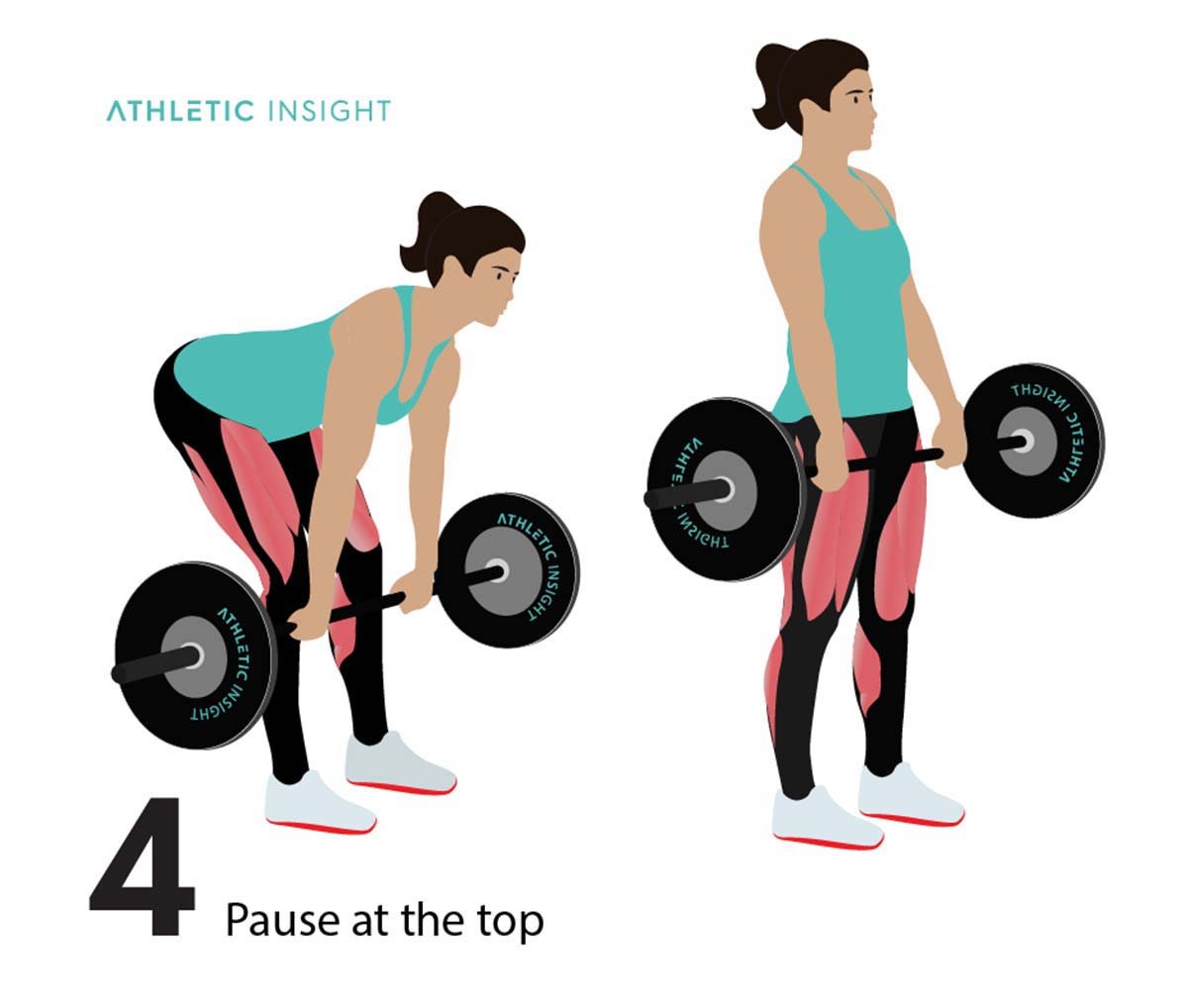
How to Avoid Injury While Performing Romanian Deadlift
Like any exercise involving weights, the Romanian Deadlift poses a risk of injury, including muscle strains and tears. However, it is possible to sustain significant injuries that could delay training and competition. Knowing how to avoid injuries while performing a Romanian Deadlift is the best to keep athletes healthy.
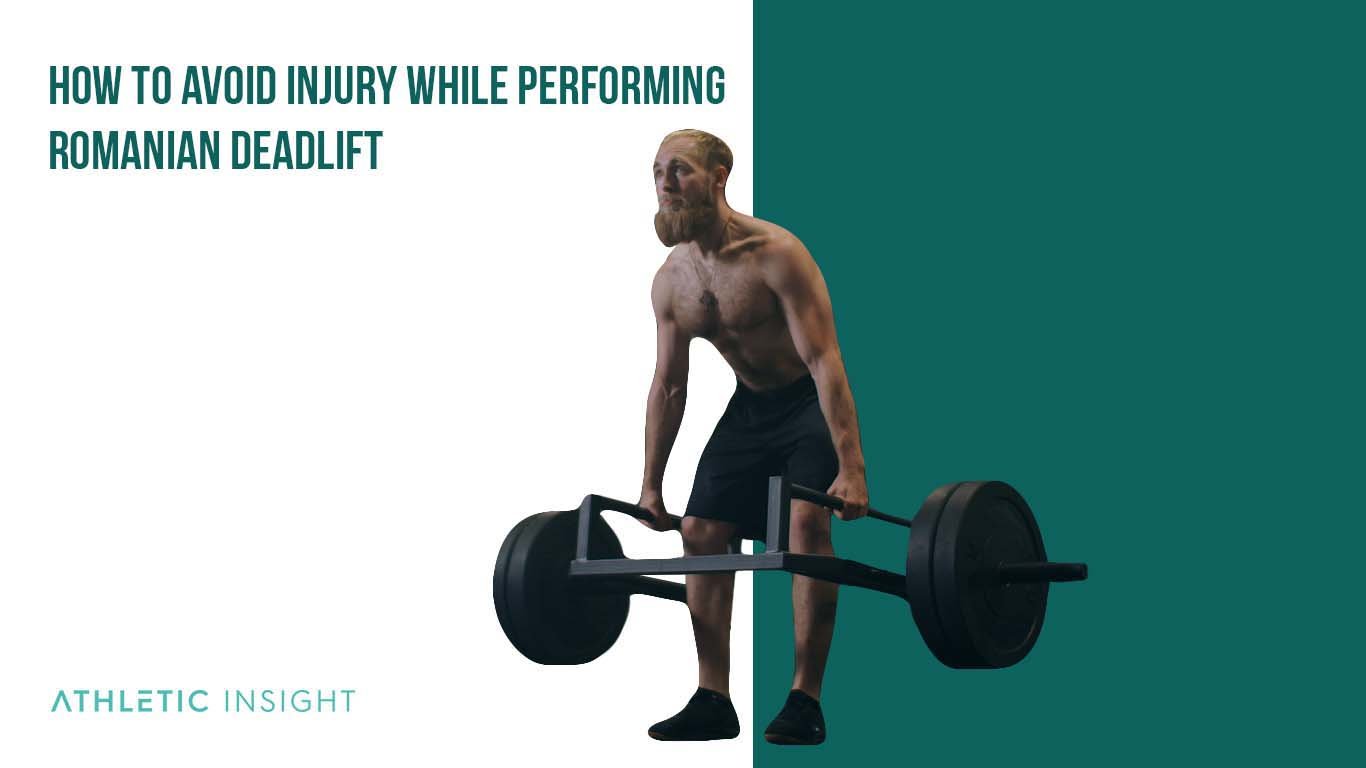
The key factors to avoiding injury while performing Romanian Deadlifts
- Support the low back with a weightlifting belt
- Keep arms and back straight
- Engage the core muscles
- Choose an overhand grip or a mixed/alternating grip
- Support wrists with braces for heavier loads
- Use lifting straps for improving the weight of the Romanian Deadlift
- Pay attention to any pain or discomfort during or after the exercise
- Keep the bar close to the body at all times
- Avoid sudden movements by moving slowly and with control
1. To Support the Low Back, Wear a Weightlifting Belt.
Since rounding the back is a common issue when performing a Romanian Deadlift, especially when lifters try to increase weight, a belt can help.
The weightlifting belt supports the spine and core so that athletes can maintain proper positions throughout a lift without straining those muscles.
2. Keep Arms and Back Straight While Lifting.
It’s necessary to keep the arms and back straight while performing Romanian Deadlifts to ensure the athlete engages the target muscles. Rounding the shoulders or bending the arms can put too much strain on the back and cause an injury.
3. Engage the Core Muscles.
Engaging the core is part of stabilizing the spine to maintain proper posture. If a lifter doesn’t engage the core or lacks enough strength to stabilize the spine, it can lead to a back injury.
4. Choose an Overhand Grip or a Mixed/Alternating Grip, With One Palm Facing Up and the Other Facing Down.
The overhand grip is best for beginners and encourages them to learn proper form. However, the mixed/alternating grip works well for advanced lifters as they increase the amount of weight it allows them to stabilize it better.
5. Support Wrists With Braces for Heavier Loads.
Like the weightlifting belt supports the spine, wrist braces secure the wrists to keep them properly aligned and avoid injury. When lifters want to increase weight or max out, wrist braces can provide the necessary support to protect the wrists and forearms.
6. Use Lifting Straps for Improving the Weight of Romanian Deadlift.
The lifting strap is another support for lifters hoping to increase weight for Romanian Deadlifts. The lifting straps go around the wrist like a bracelet and then around the bar to support the athlete’s grip to focus on other aspects of their form.
7. Pay Attention to Any Pain or Discomfort During or After the Exercise.
It’s essential to feel the muscles working throughout this exercise. However, it shouldn’t be painful. If a lifter feels pain at any point in the lift, they should stop to avoid injuring the sore area. Moving slowly through the motions allows an athlete to feel any areas of excess stress or strain and stop.
8. Keep the Bar Close to the Body At All Times.
To avoid an injury, keep the bar close to the body to move in a straight line. If the bar moves away from the body, it stresses the lower back too much.
9. Avoid Sudden Movements By Moving Slowly and With Control.
While performing Romanian Deadlifts, the lifter must use slow, controlled motions for every rep. Jerky movements or rocking can strain muscles and cause athletes to lose control of their weight.
What Are the Mistakes for Romanian Deadlift Form?
There are several Romanian Deadlift Mistakes that people make with the Romanian Deadlift form, including the following.
- Rounding the spine
- Rounding the shoulders
- Letting the bar drift away from the body
- Looking up instead of tucking the chin
- Using the knees incorrectly
1. Rounding the Spine
The good Romanian Deadlift form involves a neutral spine. Keeping the back flat and straight throughout the movement prevents athletes from straining their lower back muscles. Engaging the core to stabilize the spine is crucial.
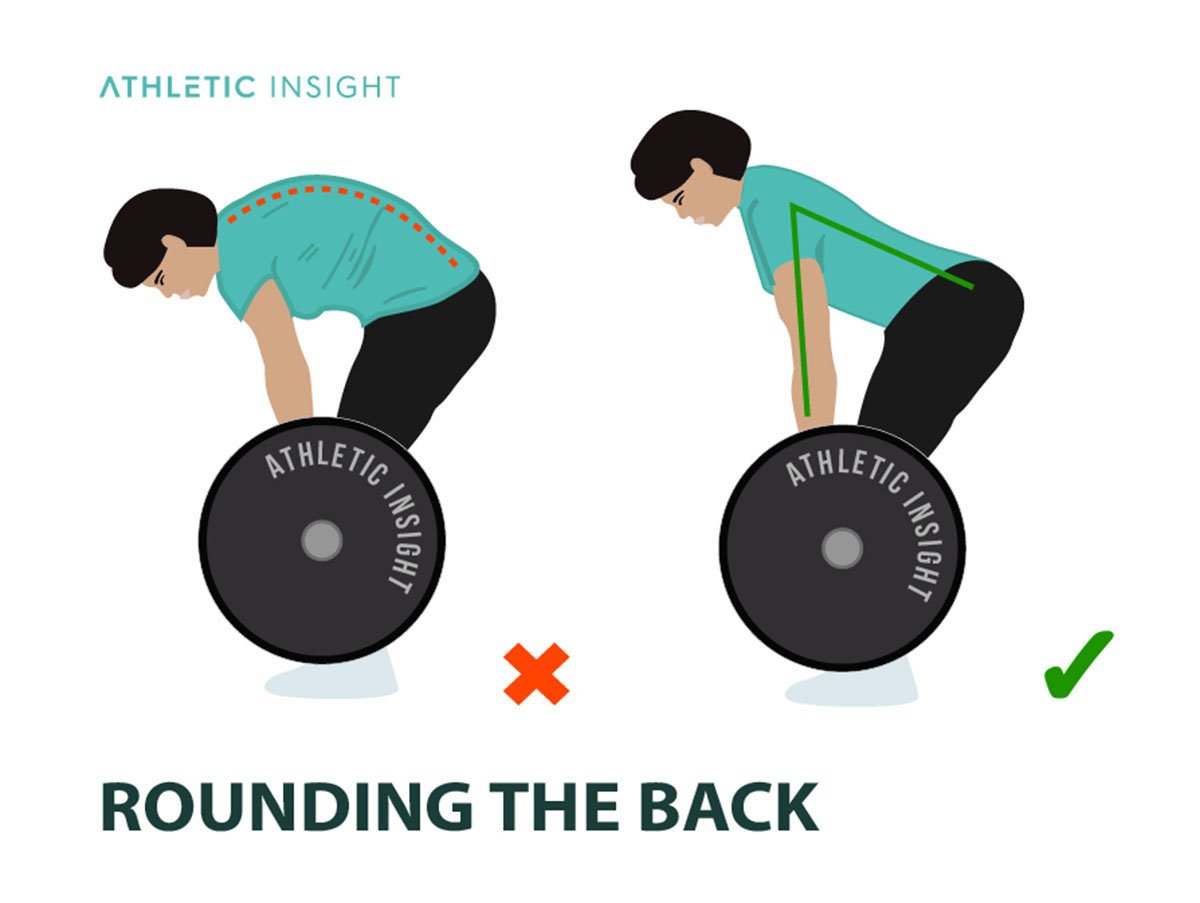
2. Rounding the Shoulders
Also known as shrugging the shoulders, this failure in Romanian Deadlift form usually occurs when the athlete reaches forward instead of down toward the feet. Shifting the bar closer to the ankles, so it’s easier to grasp is an easy fix, but athletes should also try squeezing their armpits together to engage the traps and rhomboids.
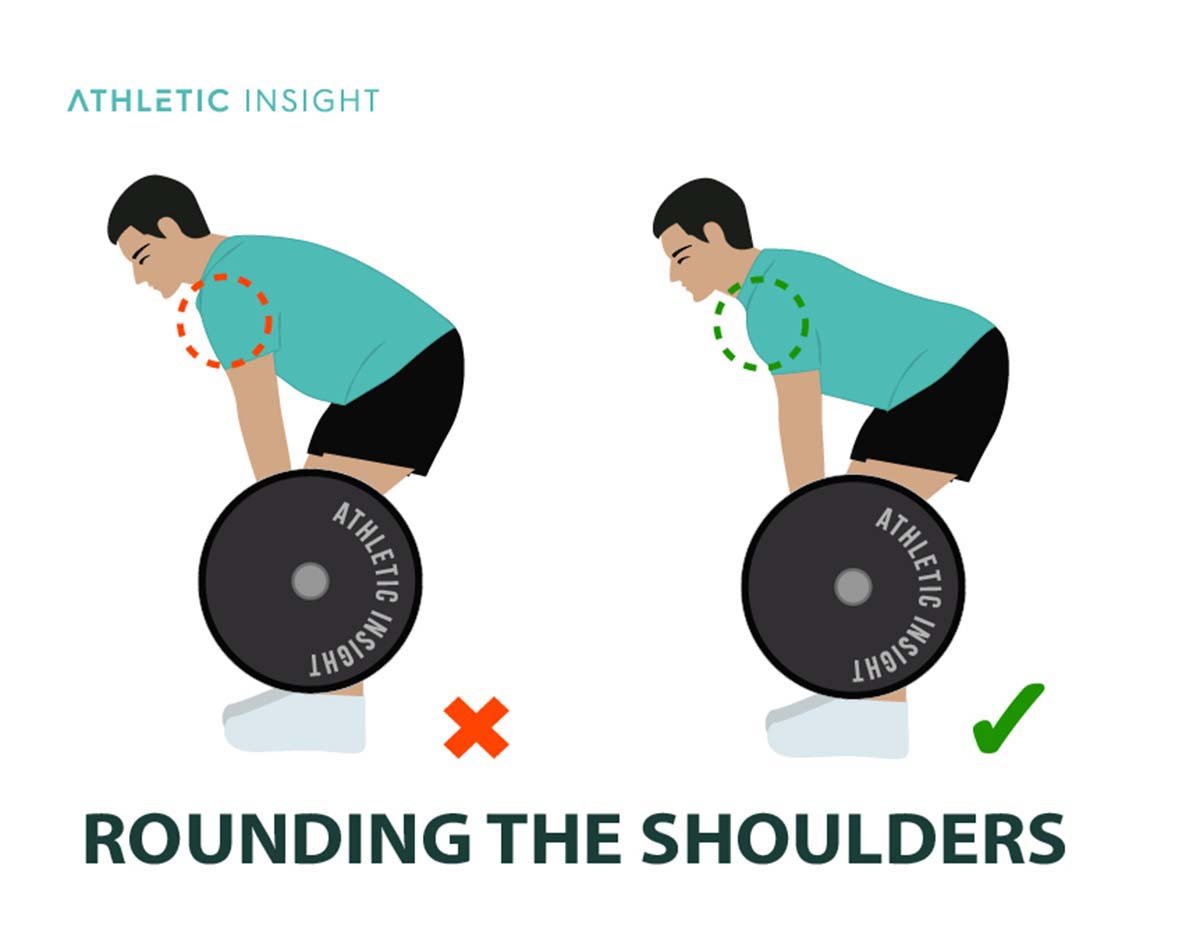
3. Letting the Bar Drift Away From the Body
Part of maintaining an excellent Romanian Deadlift form involves moving the bar in a vertical line, which means keeping the weight close to the body. When the bar drifts too far from the body, it’s often because the lifter isn’t engaging their lats to keep the bar in line.
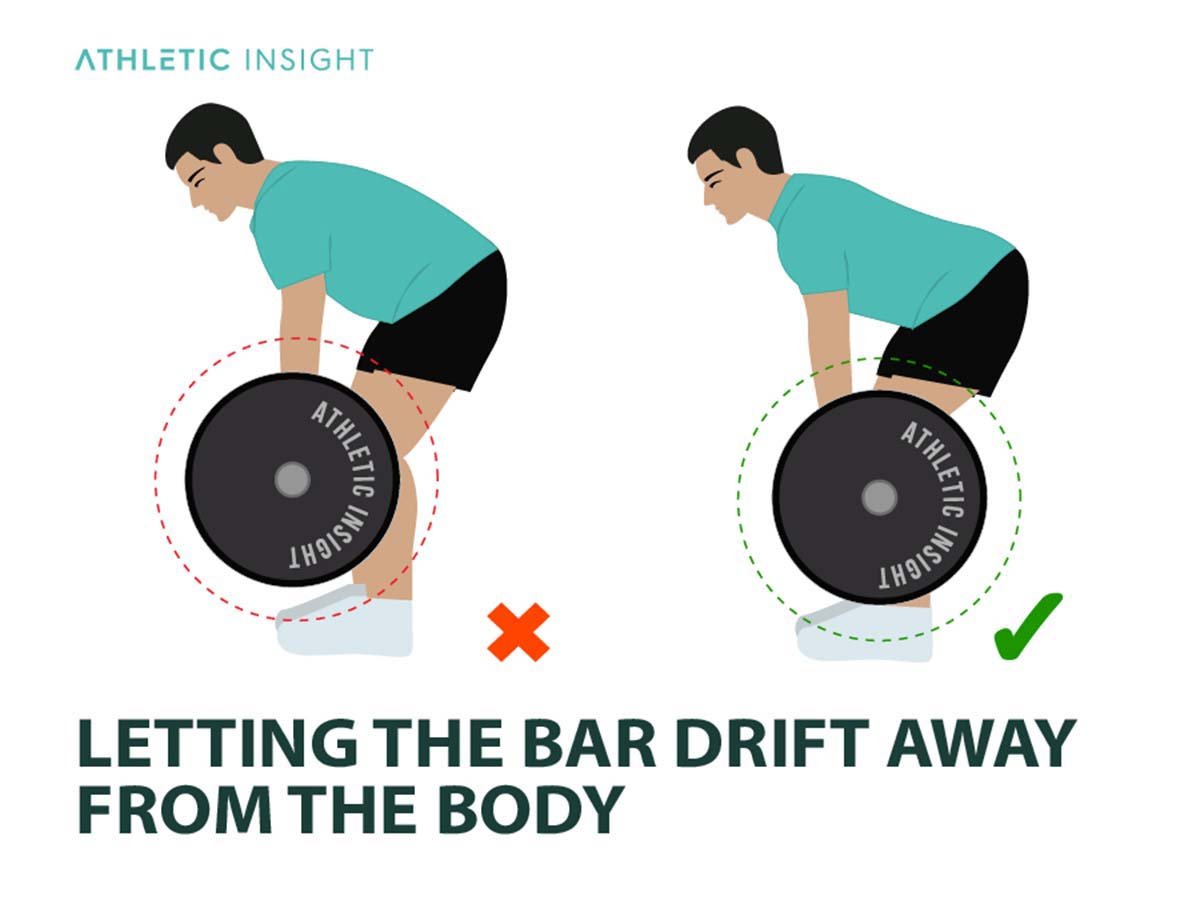
4. Looking Up Instead of Tucking the Chin
Keeping the spine in a neutral position includes the neck. When athletes look up, even to watch themselves in a mirror, it can strain the spinal erectors and other muscles around the neck, shoulders, and upper back.
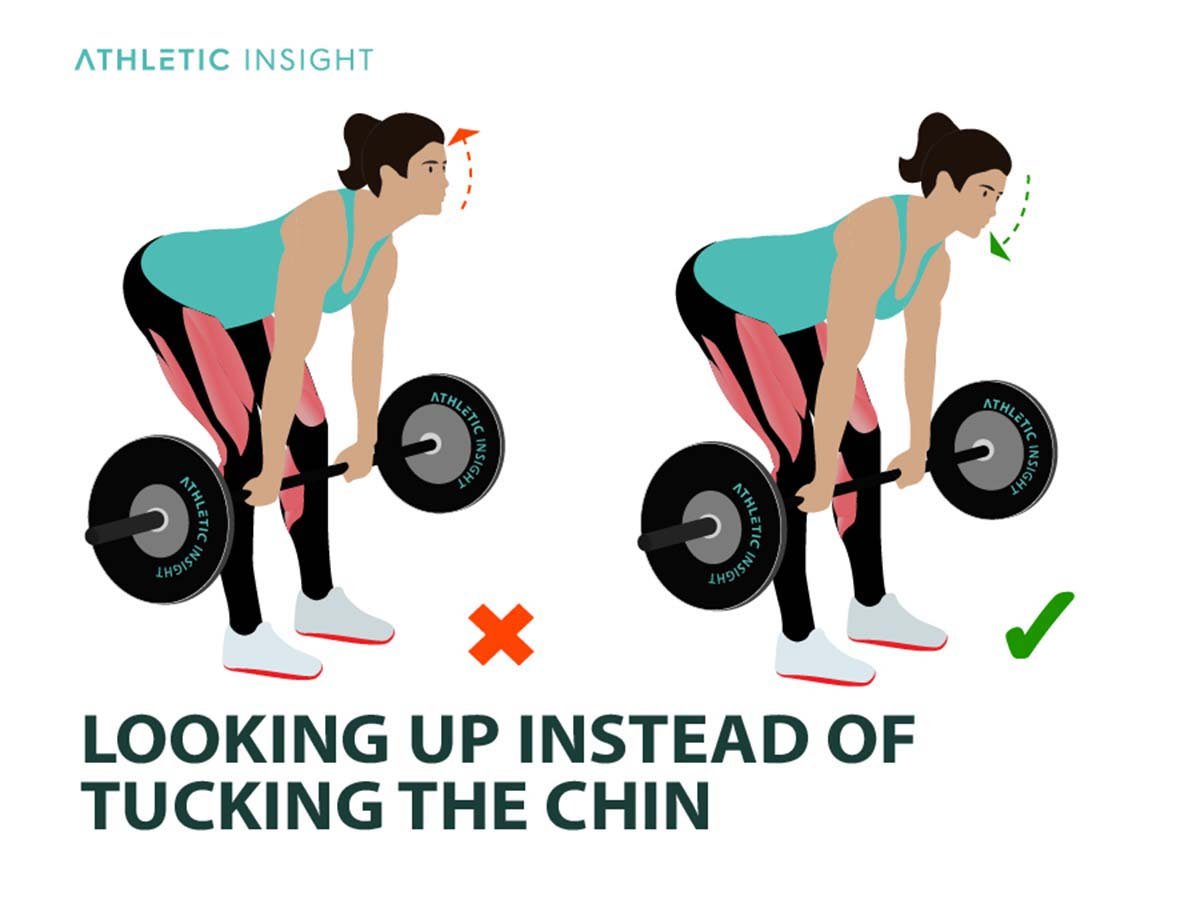
5. Using the Knees Incorrectly
While athletes should have a slight knee bend at the beginning of this exercise, bending the knees too much or too far forward is incorrect. Remember, this exercise is about working the hips to get a nice, deep stretch in the hamstrings. Bending the knees too much negates that effect.
How to Determine Proper Weight for Romanian Deadlift?
Since Romanian Deadlifts are more about feeling the stretch, it’s not necessarily an exercise most people max out with. It’s more important to choose a weight that allows the athlete to maintain proper form, use slow, controlled movements, and feel the muscles work.
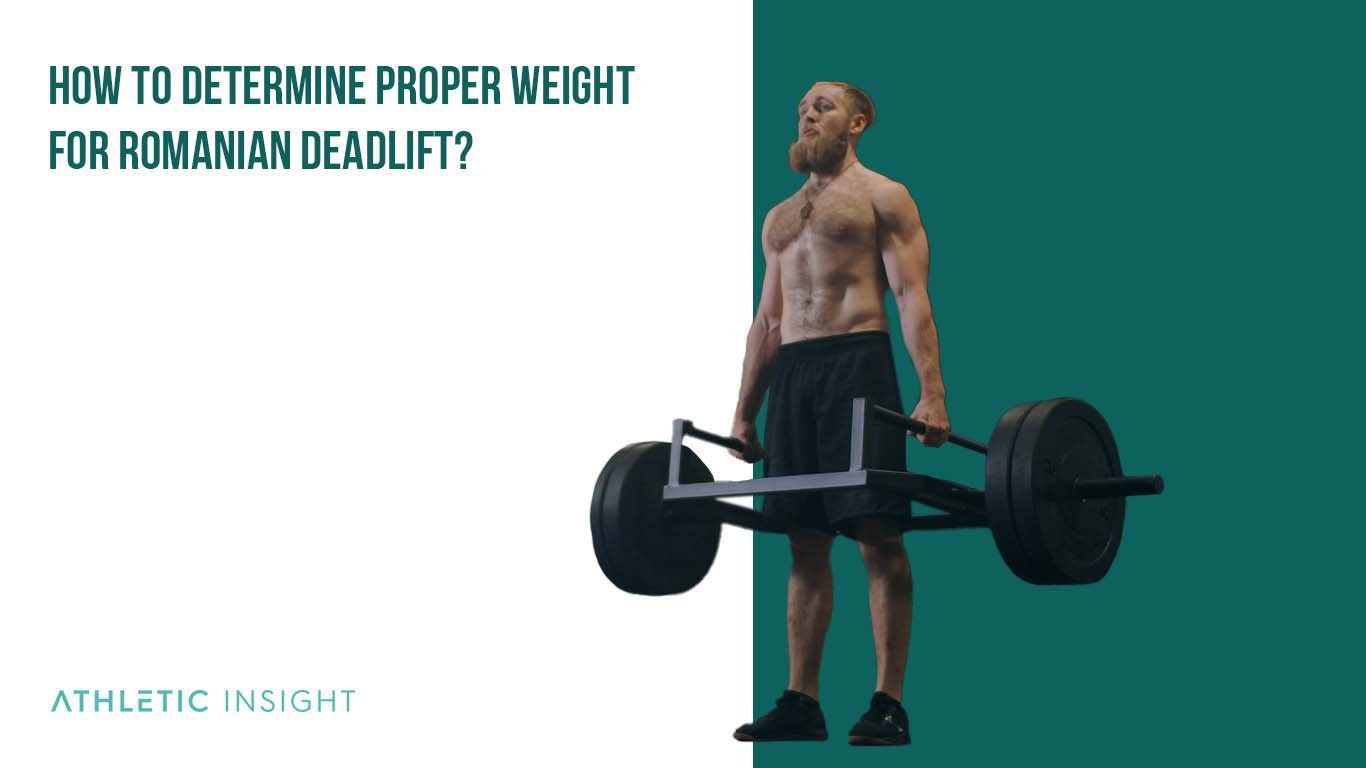
Beginning lifters might want to start with just the bar until they master the proper form and can manage it comfortably. More advanced lifters can experiment and add as much weight as they can manage while keeping acceptable form through all reps.
What is the Importance of Grip for Romanian Deadlift?
The grip is essential for Romanian Deadlifts because it allows the athlete to lift the bar and provides stability to maintain proper form throughout the lift. The grip matters because some grips provide more control over the bar than others for different movements.
For the Romanian Deadlift, an overhand grip is best for beginners because it helps stabilize their arms and control the bar to maintain proper form. More advanced lifters might switch to an alternating grip because they have the appropriate grip strength to handle it and require the mixed approach for stability during heavier lifts.
Which Muscles Are Involved While Performing Romanian Deadlift?
The Romanian Deadlift is a whole-body exercise because it targets several muscle groups while increasing flexibility, grip strength, and overall power.
Key muscles targeted during this exercise include the following.
- Forearms
- Traps
- Spinal Erectors
- Abs
- Glutes
- Hamstrings
1. Forearms
There are several muscles in the forearms, including the flexor digitorum profundus and brachioradialis. These muscle groups remain engaged through the entire exercise, which builds and tones the muscles.
2. Traps
One of the most common errors with this exercise is rounding the back and shoulders, but engaging the traps helps the athlete maintain proper form. Employing the traps for stability builds strength and endurance in these mirror muscles.
3. Spinal Erectors
The spinal erectors support the spine, making them one of the key muscle groups that benefit from this exercise. Unfortunately, poor form leaves them susceptible to strains and tears, so engaging them throughout the Romanian Deadlift is crucial.
4. Abs
The core muscles do their fair share of work during a Romanian Deadlift. Keeping the core engaged through each rep is necessary to maintain a stable, neutral spine. It builds endurance and strength, even if athletes use lighter weight.
5. Glutes
Hinging at the hips pulls the glutes into this exercise. The Romanian Deadlift works the glutes to build strength and mass while increasing endurance.
6. Hamstrings
Perhaps the biggest winner in this exercise has to be the hamstrings. The slightly flexed knee allows athletes to target the hamstrings and feel that stretch. The Romanian Deadlift is one of the best exercises to build massive hamstrings.
How to Master Romanian Deadlift
Some athletes might struggle to master the Romanian Deadlift. Beginners might want to start more easily and only do part of the process until they have the strength and control to dominate Romanian Deadlift techniques.
A beginner-friendly variation that can help an athlete prepare for the full Romanian Deadlift follows these steps.
- Grip the bar or weight instead of starting on the ground.
- Drop the weight slowly with a slight knee bend, hip bend, and straight back.
- Lower the weight until there is a slight hamstring stretch.
- 4. Drive the hips forward and use the hamstrings to stand up.
1. Grip the Bar or Weight, Instead of Starting on the Ground
Instead of starting with the bar on the ground, set it up on a rack at mid-thigh level or have a spotter hand it to the athlete.
This approach allows athletes to begin in the standing position, which would be the top of the motion. It is a way to reverse-engineer the exercise to learn the proper form by starting with the back straight.
2. Drop the Weight Slowly With a Slight Knee Bend, Hip Bend, and Straight Back
At this point, the athlete moves the bar down the body, following with the shoulders, hips, and knees. Working backward allows the lifter to feel how the muscles should work and focus on keeping proper form. It’s also easier to control the bar during this part of the exercise so that beginners can master it, and advanced lifters can practice with heavier weights.
3. Lower the Weight Until There Is a Slight Hamstring Stretch – Usually Just Past the Knee
As athletes master the first two steps, they can progress until they notice the slight hamstring stretch that marks the pause point for this approach. By not taking the weight all the way back to the ground, they can focus on maintaining that form and isolating the hamstrings to build strength, definition, and endurance.
4. Drive the Hips Forward and Use the Hamstrings to Get Back Up to Standing
Finally, drive the hips forward and engage the hamstrings to stand back up without rounding the back or shoulders. The benefits of the Romanian Deadlift here would be building power and endurance for a full Romanian Deadlift or increasing the weight.
What Are the Romanian Deadlift Variations?
Romanian deadlift variations typically increase the exercise difficulty for intermediate to advanced lifters. They offer ways to increase endurance and stability.
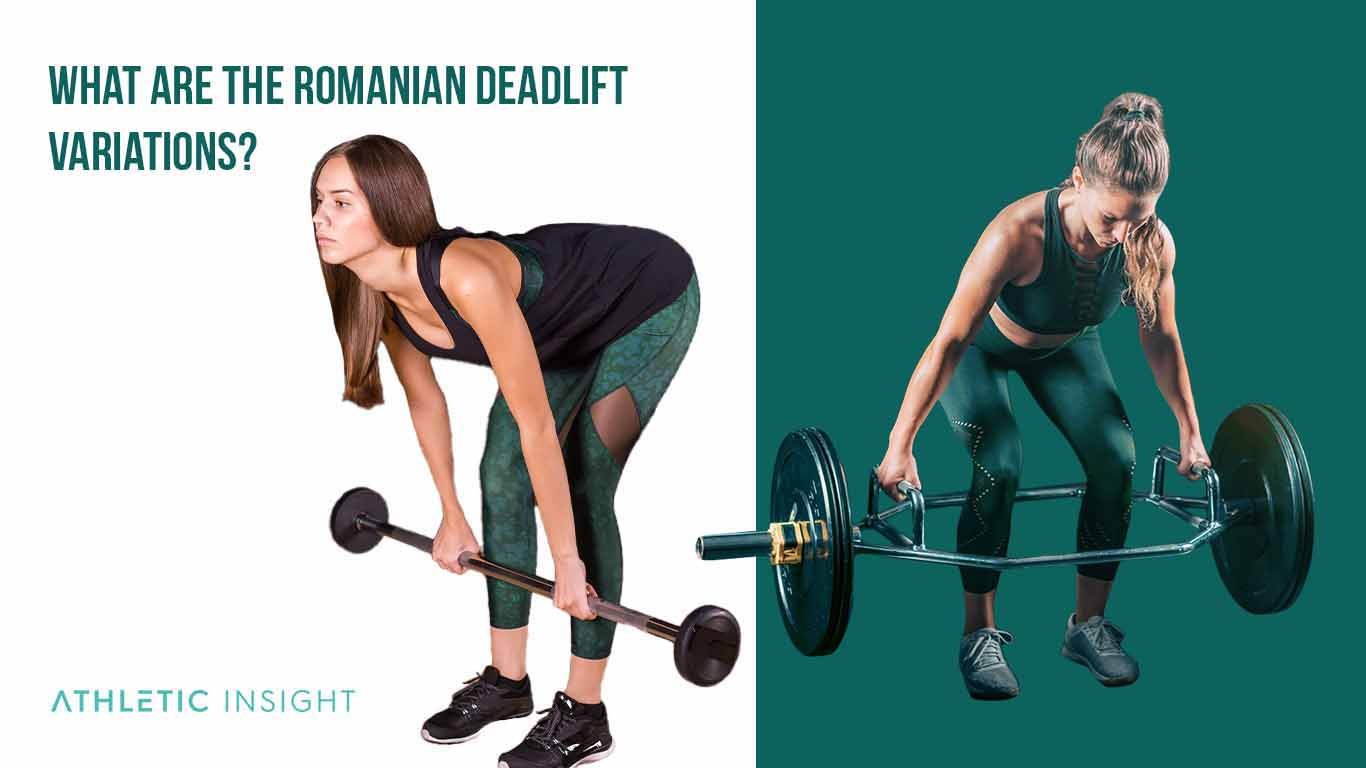
Typical variations include bodyweight Romanian Deadlift techniques, like the single-leg RDL, or swapping out the barbell for alternative equipment, like dumbbells or a trap bar. The main features of these variations of the Romanian Deadlift involve working the body differently and isolating the muscles in new ways to build power, mass, endurance, or all three.
1. Single-Leg Romanian Deadlift
The Single-Leg Romanian Deadlift is a variation of a variation that requires athletes to perform an RDL while balancing on one leg. It’s excellent for improving balance and lower body stability while adding explosiveness to the legs.
To perform a Single-Leg RDL, follow these simple steps.
- Stand on the left leg with the knee slightly bent.
- Hold a weight in the right hand just before the right thigh.
- Hinge at the hips like a regular RDL and extend the right leg behind as the weight moves toward the ground.
- Keep the back flat, and bend at the waist until the weight is around the mid-shin region.
- Push the hips forward to pull back up to the starting position.
Common mistakes for this exercise include the following.
- Rounding the back,
- Letting the weight drift too far from the body
- Failing to use the core and glutes to maintain balance
Equipment for this variation can be almost anything that the lifter can hold in one hand. Most people use a dumbbell or kettlebell, but beginners might want to try it without weights until they master the proper technique.
The muscles worked by this Single Leg Romanian Deadlift include the following.
- The hamstrings
- Glutes
- Abs
- Upper back muscles
Since the Single Leg Romanian Deadlift is more of a bodyweight variation, it’s easy to do anywhere, unlike the traditional barbell variation that requires a bar, plates, and a collar. Plus, the Single Leg variation supports lower body stability, especially around the knees, which can help with injury prevention.
2. Dumbbell Split-Leg Romanian Deadlift
The Dumbbell Split-Leg Romanian Deadlift, also known as the Split Stance Romanian Deadlift, is practical because it engages the hamstrings and glutes from different angles. This variation requires the athlete to stand with one leg in front and the other behind, which alters the angles of the muscles while improving balance.
The proper form for this variation begins with the appropriate stance.
- With shoulders in line with the hips, move one forward and the other slightly back for a staggered stance.
- Grasp the weight with the hands just outside the shoulders on a barbell or a neutral grip on dumbbells.
- Hinge at the hips to lower the weights to around mid-shin.
- Then push back up to the starting position.
Possible mistakes for this variation include using an incorrect stance, rounding the back, and letting the weight go too far down. It’s a good idea to experiment with the stance to make sure the athlete feels comfortable and engages the hamstrings without losing balance or experiencing pain.
The necessary equipment for this variation is a barbell, dumbbell, or kettlebell. This variation primarily works the hamstrings and glutes. However, the low back muscles, abs, and obliques help the lifter maintain balance and stability through the spine.
The Dumbbell Split-Leg RDL is similar to the Single Leg variation and might be a starting point for beginners. If a lifter can’t maintain balance on one leg, the Split-Leg variation is a great way to work on balance and increase strength to step up to the Single Leg variation.
3. Trap-Bar Romanian Deadlift
The Trap-Bar Romanian Deadlift is a beginner variation that uses a trap bar instead of a barbell. Using a trap bar alters the hand placement to a neutral grip and shifts weight distribution, which helps the athlete keep their back straight.
Proper form for this variation is essential.
- Start with stepping inside the trap bar with feet in line with the hips.
- Grasp the handles with a neutral grip and pull the weight into a standing position.
- With a slight bend in the knees, hinge at the hips to lower the bar.
- Stop when the trap bar reaches below the knee, then drive back up to the starting position.
A mistake that often happens with this variation is letting the bar drift too much. Like every other version of the Romanian Deadlift, the athlete should keep the bar close to the body to maintain proper form and avoid straining the back.
The equipment for this variation includes a trap bar. Trap-Bar Romanian Deadlift muscles worked include the following.
- Hamstrings
- Glutes
- Lower back
- Lats
- Abs
- Forearms
This variation is an excellent Barbell Romanian Deadlift substitute because the alternate equipment helps the athlete maintain a neutral spine. It’s a perfect choice for beginners who struggle with the traditional version because it uses a neutral grip and the trap bar limits some range of motion to support better form.
4. Dumbbell Romanian Deadlift
This variation is simply a Romanian Deadlift with dumbbells instead of a bar with weight plates. The Dumbbell Romanian Deadlift is an excellent choice for beginners and those with low back pain because there’s more range of motion, and you can do it with little to no weight.
- Stand with the feet in line with the shoulders and knees slightly bent.
- Holding the dumbbells in front of the body, hinge forward at the hips to lower the dumbbells.
- When the athlete feels the stretch through the hamstrings, pause, then thrust with the hips to return to the starting position.
Possible mistakes for this variation include the following.
- Using momentum instead of muscle to move the weights
- Rounding the back
Even though lifters have more range of motion with this variation, the Dumbbell Romanian Deadlift requires a neutral spine.
The equipment necessary for this variation would be dumbbells. However, lifters can use almost any type of weight, including books or water bottles.
This variation primarily works the hamstrings and engages the glutes, hip flexors, and lower back muscles.
The Dumbbell Romanian Deadlift is a Conventional Romanian Deadlift alternative that restricts the amount of total weight lifted but provides a greater range of motion for the joints. It’s also a safer option for people who have low back pain because it doesn’t limit the joints as much.
What Is the Necessary Equipment for Romanian Deadlift?
One of the best things about adding a Romanian Deadlift to a workout routine is the limited equipment necessary. For most variations of the Romanian Deadlift, athletes only need the following equipment.
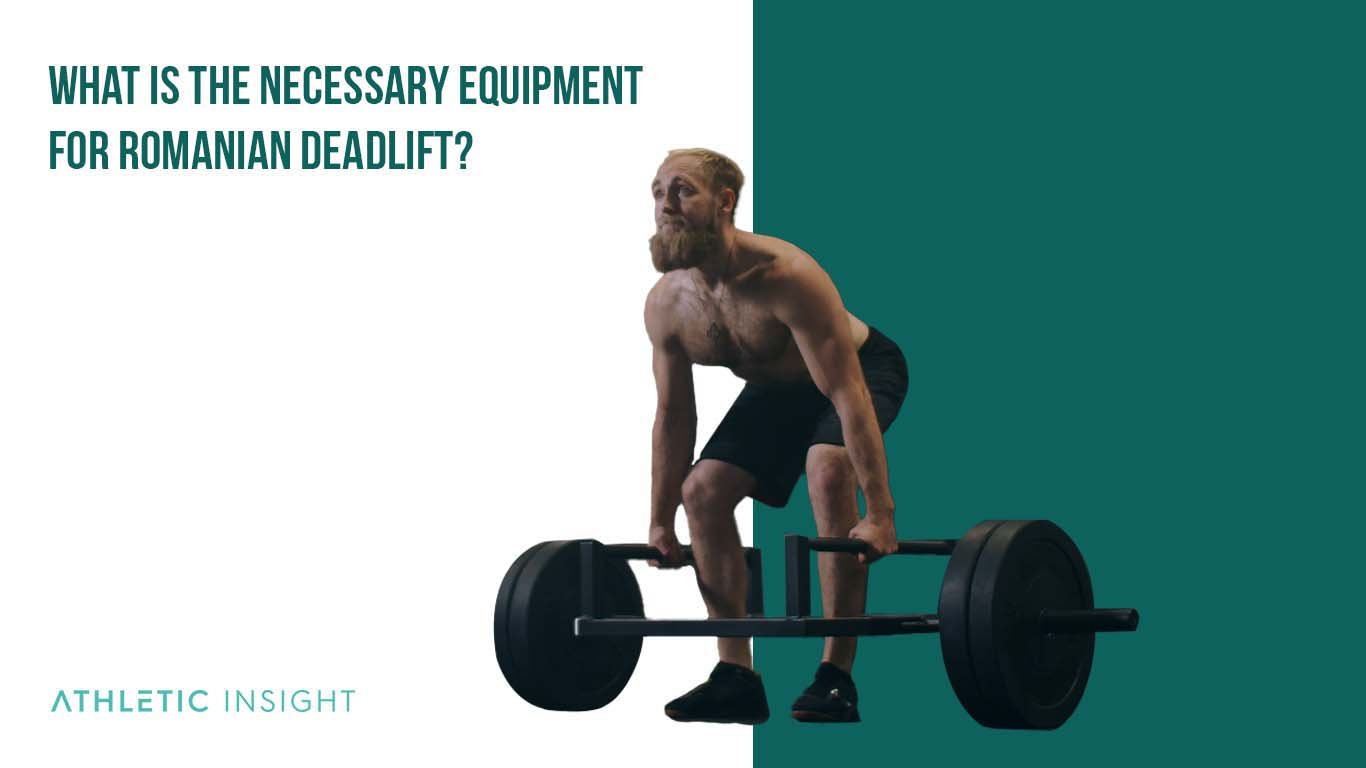
- Barbell, dumbbells, or trap bar to lift during the exercise.
- Weight plates to add weight to the barbell.
- Bar collars to secure the weight plates on the barbell.
Additionally, some athletes might want to use the following equipment such as a weightlifting belt for spine and core support and lift straps to support grip during the lift.
What Are the World Records for Romanian Deadlift?
While there are several world records for the traditional deadlift, the Romanian Deadlift is not a competitive event. Most athletes use the Romanian Deadlift as an accessory exercise that helps build power, grip strength, and endurance to improve their traditional deadlift.
Women Romanian Deadlift Records
There are no women’s world records for the Romanian Deadlift because it’s not something that’s typically tracked. However, several women with outstanding traditional deadlift records acknowledge that performing sets of Romanian Deadlifts helped them prepare.
Men Romanian Deadlift Records
Since Romanian Deadlifts aren’t exactly competitive lifts, there are no recorded world records. Like the women, male athletes often use the Romanian Deadlift to improve their performance for traditional deadlifts.
What Is the Origin of Romanian Deadlift?
The history of the Romanian Deadlift is not especially exciting. American lifters witnessed a Romanian performing them as a warmup at the Olympics.
Nicolae “Nicu” Vlad was a Romanian Olympic weightlifter during the 1980s and 1900s who won multiple medals and championships during his career. He used the exercise as a warmup before competing in the traditional deadlift.
Given Vlad’s success, other athletes started incorporating the Romanian Deadlift into their routines. Popularity grew from there, and today many competitive weightlifters use the Romanian Deadlift as a warmup.
Who Named the Romanian Deadlift?
American lifters named the variation after the Romanian Olympic athlete Nicolae Vlad. They saw him doing them before he medaled and named the exercise for his nationality.
Which Muscles Can Be Affected More From Romanian Deadlift?
Though the Romanian Deadlift is a compound lift that works several muscles, it targets a few more than others.
- Hamstrings
- Glutes
- Forearms
The hamstrings get the most work during this exercise because they handle most of the load. With a slight bend to the knee and the hip thrust to move the bar, the athlete engages the hamstrings and should feel a nice stretch.
That said, the glutes and forearms put in their fair share of work. The glutes participate in the hip thrust to propel the bar up the body. Of course, the forearms maintain the bar’s position and work to support the wrists and grip throughout the exercise.
What Are the Back Muscle Exercises with Romanian Deadlift?
Most people think about the hamstrings when they think about RDLs. However, discerning athletes will include Romanian Deadlift for best back exercises workout routines.
Since RDLs require athletes to engage the back muscles for stability, it’s an excellent accessory workout for back day routines. Try this sample workout.
- Romanian Deadlift, 3 sets of 8 reps at a moderate weight
- Barbell Rack Row, 3 sets of 10 reps at a moderate weight
- Cable Lat Pull Downs, 3 sets of 10 reps at a moderate weight
The Romanian Deadlift serves as a warmup for the entire body in this back workout routine, including the back muscles. The athlete then moves into other exercises that precisely target specific back muscles.
What Are the Leg Muscle Exercises with Romanian Deadlift?
Adding the Romanian Deadlift for leg workouts is a no-brainer. It’s one of the top exercises for building the hamstrings while working the whole body.
Here is a sample leg day workout that uses the Romanian Deadlift.
- Back Squats with bar, 3 sets of 8 reps with moderate weight
- Romanian Deadlift, 3 sets of 8 reps with moderate weight
- Sumo Deadlift, 3 sets of 8 reps with moderate weight
In this case, the Romanian Deadlift serves as a bridge and break between squats and another deadlift variation. It also warms lifters up for the Sumo Deadlift.
What Is the Effectiveness of Romanian Deadlift for Muscle Growth When Compared to Squat?
Neither the Romanian Deadlift nor Squat is better than the other. Lifters should include both exercises for a well-rounded routine.
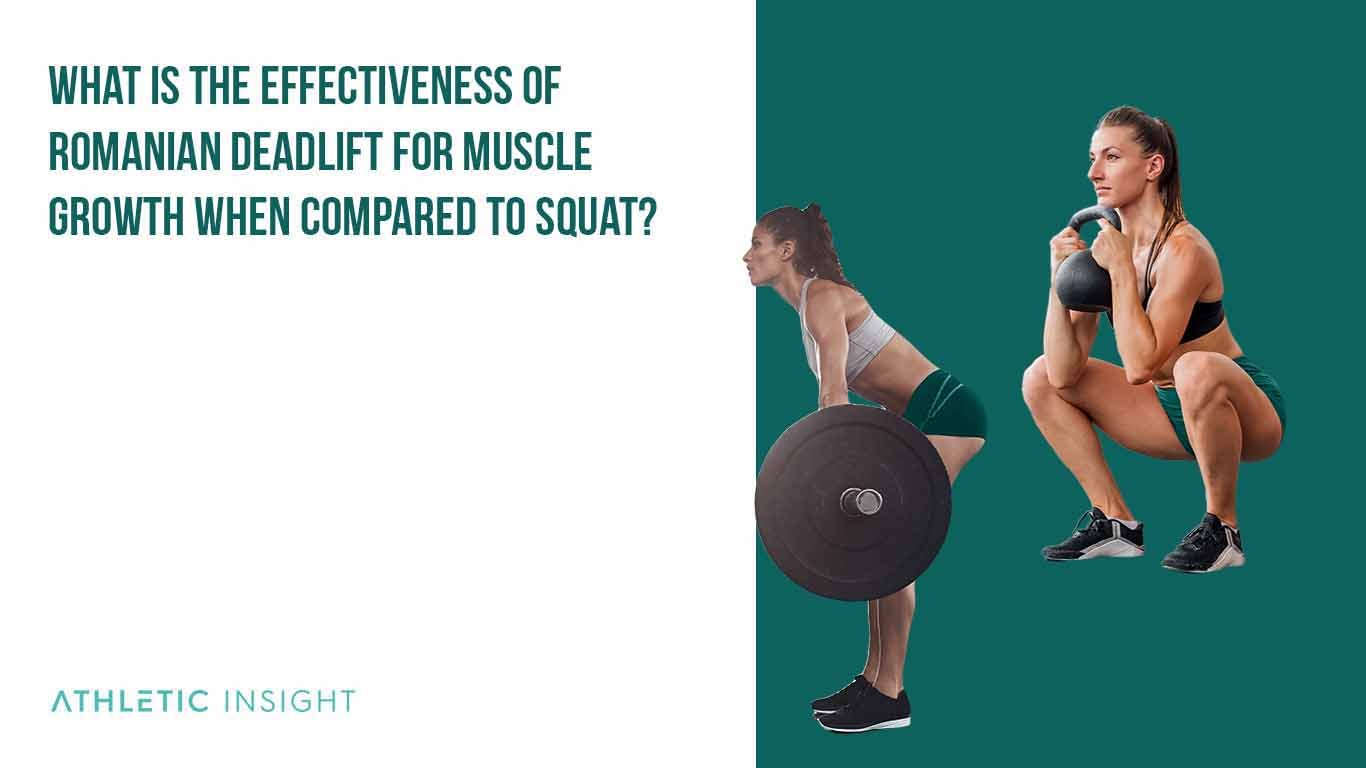
Squats engage the glutes, quads, and hamstrings to build strength, while the Romanian Deadlift works the hamstrings and glutes. There is some overlap, and both can increase strength and endurance.
The Romanian Deadlift is one of the best ways to strengthen and build mass in the hamstrings. By targeting the hamstrings throughout the lift, the lifter can increase their muscle mass without using massive amounts of weight.
What Are the Romanian Deadlift Related Facts?
It helps many athletes have a comprehensive understanding of each exercise they perform. Some helpful related fact questions include the following.
- Does the Romanian Deadlift affect the hormones?
- Does the Romanian Deadlift increase testosterone?
- Does the Romanian Deadlift affect the mood?
- Is the Romanian Deadlift practiced within CrossFit?
- Is the Romanian Deadlift a military movement?
- Is the Romanian Deadlift dangerous?
- Is the Romanian Deadlift push or pull?
- Is the Romanian Deadlift essential?
- Is the Romanian Deadlift an Olympic lift?
- Which is better: Romanian Deadlift or Barbell Deadlift?
- Does Bodyweight Romanian Deadlift burn more calories?
We thoroughly researched the following answers to provide concrete responses, not opinions.
Does Romanian Deadlift Affect the Hormones?
Yes, the Romanian Deadlift does affect hormones. The Romanian Deadlift helps the body regulate anabolic hormones, which can trigger the following.
- Testosterone
- IGF
- Human growth hormone
Since these are the main hormones involved in the growth and repair of muscle tissues, it’s no surprise that lifters see notable gains.
This exercise also increases the body’s metabolism to burn more calories. For many lifters, even beginners, that translates to burning off fat.
Does Romanian Deadlift Increase Testosterone?
Yes, performing the Romanian Deadlift increases testosterone. While testosterone is more often associated with men, it is produced by women as well.
Since testosterone is an anabolic hormone, it’s responsible for bone mass, muscle mass, and fat distribution. By performing the Romanian Deadlift, athletes prompt the body to produce more to help grow and repair the muscles.
Does Romanian Deadlift Affect the Mood?
Yes, the Romanian Deadlift affects the mood. The Romanian Deadlift is a compound exercise that gets the entire body moving, boosts the heart rate, and triggers the release of endorphins. Since endorphins make athletes feel good, the Romanian Deadlift can give them a mood boost.
Is Romanian Deadlift Practiced Within CrossFit?
Yes, the Romanian Deadlift is used by CrossFit athletes. It’s a whole-body exercise that works for multiple muscle groups and supports other athletic movements.
Since athletes also notice increased grip strength and flexibility, it’s no surprise that CrossFit athletes often incorporate the RDL into workout routines.
Is the Romanian Deadlift a Military Movement?
No, the Romanian Deadlift is not a military exercise. While the Romanian Deadlift is popular among many lifters, including those in the military, it’s not a part of any testing.
Still, many recruits rely on the exercise for training because of the opportunity to improve performance across measurable exercises, including push-ups and pull-ups.
Is Romanian Deadlift Dangerous?
No, the Romanian Deadlift is not dangerous, provided it’s performed correctly. Many lifters with low back pain actually find that the Romanian Deadlift is an easier variation of the traditional exercise because it works the muscles differently and doesn’t create as much strain.
Is Romanian Deadlift Push or Pull?
The Romanian Deadlift is a Pulling exercise. The Romanian Deadlift is a pull exercise since the lifter pulls the bar from the ground and then lowers it again.
Is Romanian Deadlift Essential?
No, the Romanian Deadlift is not essential because other exercises and variations can accomplish similar results. However, many lifters use the RDL because it’s enjoyable and an excellent way to engage the hamstrings while working other muscles.
Is Romanian Deadlift an Olympic Lift?
No, the Romanian Deadlift is not an Olympic lift. Though it has roots in the Olympics, the RDL is a variation exercise that serves more as an accessory or warm-up for the main lifting events.
Which is Better: Romanian Deadlift or Barbell Deadlift?
Neither Romanian Deadlift nor Barbell Deadlift is better. The Romanian Deadlift is a variation of the Barbell Deadlift, so the two exercises are pretty similar.
Since the RDL doesn’t lift the bar overhead, it’s better for people with low back issues. However, the Barbell Deadlift is better for building low back muscles because it involves lifting the bar overhead.
The RDL is an excellent exercise for increasing the amount of weight a lifter can deadlift. It’s helpful for beginners who need to learn proper form and lifters who want to work with lighter weights to isolate the hamstrings. The downside is that this variation is not suitable for maxing out, and it’s not a competitive lift.
Barbell deadlifts remain a staple in nearly every lifting program, and it’s a competitive lift in many areas. The barbell deadlift is a marker for strength among athletes. However, lifters are more prone to low back injuries because it can put too much strain on the erectors.
Does Bodyweight Romanian Deadlift Burn More Calories?
Yes, the Bodyweight Romanian Deadlift burns more calories than other variations. The primary bodyweight Romanian Deadlift is the single-leg variation. Since the lifter must maintain proper form while balancing on one leg, they work more muscles in different ways and ultimately burn more calories.
Beginners can just focus on form and balance, while more advanced lifters can add weights, like dumbbells or kettlebells, to increase the challenge.
Bodyweight RDLs are excellent additions to any workout because they can be performed anywhere without requiring specific weights. People could do them at home with books or water bottles if they desire.

